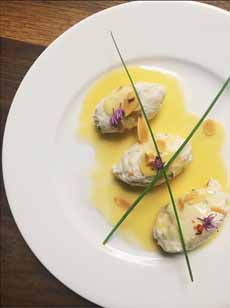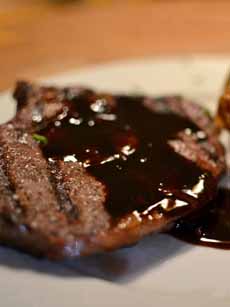TIP OF THE DAY: Beurre Blanc, Beurre Noir & Beurre Noisette
|
Yesterday we wrote about LoveTheWild, a line of frozen fish entrées with pats of flavored butter (compound butter) that melt into a sauce. The concept of compound butter comes from French cuisine, but French butter sauces don’t stop there. Today, we take on three butter preparations that are used as sauces—sauces that you can easily make to spruce up your evening meal. You don’t need a lot of it to add richness to your dish. There are other French butter-based sauces, of course. > Check out the different types of butter in our photo glossary. > The history of butter. French for white butter, beurre blanc is a hot emulsified butter sauce made popular in Loire Valley cuisine. There it is made with Muscadet, the region’s best-selling white wine, which has been made since the late 16th or early 17th century. The ingredients of beurre blanc—and the other sauces in this article—are simple: To make the emulsion, cold, whole butter is blended into the hot reduction of wine and vinegar. It is similar to the mother sauce hollandaise in concept, but is considered neither a mother sauce nor a compound butter. Beurre rouge, a variant of beurre blanc sauce, is made by substituting a dry red wine for the white wine and red wine vinegar for the white wine vinegar. The red wine supplies color and more of a tang. Here’s a recipe for beurre blanc. The story is that she intended to prepare a béarnaise sauce for a pike dish, but forgot to add the tarragon and egg yolks. For more depth of flavor, the butter is cooked longer. A step up from beurre blanc is beurre noisette (photo #2). Literally meaning hazelnut butter, but commonly referred to as brown butter, it is melted butter that’s cooked until the milk solids turn the light golden brown color of hazelnuts and the butter gives off a nutty aroma. Beurre noisette is popular for sautéeing and saucing meat, poultry, fish and fruit; as a sauce for pasta and vegetables; and in baking biscuits, cakes and cookies. We like it with polenta and grains. |
[3] Beurre noir is butter cooked until it turns a very dark brown (photo courtesy Alchetron). |
|
|
BEURRE NOIR (BLACK BUTTER SAUCE) French for black butter, the butter is cooked over low heat until it turns dark brown (not literal black—photo #3). When the sauce turns brown, a few drops of red wine vinegar or lemon juice are added. Some recipes add capers and parsley or thyme. Modern cooks have amended the recipe to include balsamic vinegar, garlic, even minced hot chiles (essentially, sauces that should be called balsamic beurre noir, garlic beurre noir, etc.). Two famous classic dishes are calves brains in black butter (a dish, alas, that is not served much these days since the spread of Mad Cow Disease) and skate in black butter. Here’s a recipe for skate in black butter. Beurre noir is not to be confused with Jersey black sutter, an English speciality made by slowly cooking apples with cider, licorice and spices. It’s generally eaten on toast. Beurre monté is not a sauce, but a method of infusing meats and fish with the flavor of butter. Solid butter is an emulsification of butter fat, water and milk solids; beurre monté is a way to manipulate the emulsification into liquid form. A few drops of water and chunks of butter are whisked over a moderate heat to melt the butter and keep it emulsified—a solid, creamy sauce. Foods are cooked in it, meats are rested in it, sauces are made with it. “It’s an extraordinary vehicle for both heat and flavor.” says chef Thomas Keller. CHECK OUT WHAT’S HAPPENING ON OUR HOME PAGE, THENIBBLE.COM. |
||





